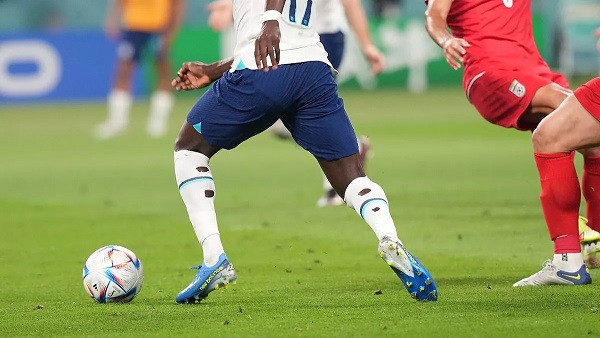
The Risks Of Not Wearing Grip Socks When Playing Football
Football, often known as soccer, is a sport that provides millions of players and supporters throughout the world with delight, camaraderie, and intense competition. Safety should always be a vital issue for all participants, whether playing professionally or recreationally. The choice of footwear, particularly red football grip socks, is a football safety aspect that requires consideration. Grip socks improve traction, stability, and overall field performance. In this blog, we’ll look at the dangers of not wearing grip socks when playing football, emphasising the necessity of suitable footwear for injury prevention and optimal gameplay.
The Importance Of Traction
Traction is essential in football because players must make quick starts, pauses, and direction changes on various surfaces. Failure to wear grip socks can substantially impact a player’s ability to retain optimum traction. Football pitches can become slick due to rain, moisture, or sweat. Without sufficient traction, athletes are more likely to slip and slide, which can result in various injuries.
Sprains and Twists
Sprains and twists are more likely with inadequate traction, especially in the ankles and knees. Rapid movements combined with a lack of grip might cause a player’s foot to give way, leading to damaged ligaments or twisted joints. These injuries can span from minor to severe, requiring considerable recovery and potentially resulting in lasting repercussions.
Muscle Strains
An inability to maintain solid footing can also cause muscle strains. When a player’s foot slips, the body’s natural response is to compensate by activating other muscle groups to maintain balance. It might strain the legs, hips, and lower back muscles. These strains can lead to chronic pain and decreased overall performance over time.
Impact Injuries
Football is a contact sport, and players frequently clash with one another or the ground during play. Grip socks can give an extra layer of protection against impact injuries. They assist players in maintaining better stability, lowering the chance of falling awkwardly and more efficiently absorbing impact.
Enhanced Stability And Performance
Improved stability and performance are desirable in any sport, and football is no different. Football players must optimise their strength and performance due to the physical prowess, technical talent, and mental understanding required to excel. Let’s look at how these elements interact and why they’re essential for football success.
Stability: The Foundation Of Success
Stability serves as the cornerstone of a football player’s performance. It includes bodily strength, balance, and mental calm. Here’s how improved steadiness can help a player succeed:
Physical Balance
Football requires a variety of motions, ranging from running and jumping to rapid changes of direction. Players must be stable to execute these moves with control and synchronisation. Stability improves the likelihood of stumbling, falling, or making uncomfortable motions that might result in injury.
Resistance to External Forces
Football is a rough sport that frequently involves collisions and challenges from opponents. Improved stability allows players to endure external forces while keeping their position and balance even in difficult situations. The ability to stay upright under pressure might mean the difference between keeping or losing possession of the ball.
Confidence
Consistency breeds confidence. Players are more willing to take calculated chances and make aggressive plays when they feel stable. In turn, belief influences decision-making, with players more likely to try skilled sports and contribute favourably to the team’s strategy.
Reduced Mental Fatigue
Stability-enhancing equipment like grip socks reduces the mental effort needed to maintain stability. It decreases mental weariness and allows players to focus on tactics, positioning, and teamwork, which improves overall performance.
Performance: Reaching The Peak Of Potential
Football performance is the sum of a player’s physical ability, technical capabilities, and mental fortitude. Improved stability has a significant impact on overall performance:
Agility and Quick Movements
Improved stability allows players to move around the field more quickly. Quick changes of direction, which are critical in escaping defenders or positioning for a shot, are more efficiently completed when a player feels solid and confident on their feet.
Optimal Acceleration and Deceleration
Football is a game of rapid acceleration followed by a controlled slowdown. Proper stability enables players to accelerate swiftly to full speed and decelerate precisely, providing them an advantage in one-on-one scenarios and tactical manoeuvres.
Effective Ball Control
Football ball control is a skill. Improved stability translates to better control over the trajectory and movement of the ball. Steady footing allows better coordination between the player’s body and the ball when receiving a pass, dribbling, or shooting.
Confidence in Aerial Play
Precise timing and location are necessary for aerial duels, such as heading the ball. Improved stability allows players to keep their balance when competing for the ball in the air, providing them an advantage over their opponents.
Consistent Performance
Stable footing helps players perform consistently in various conditions, including wet or slippery surfaces. Regardless of external variables, this constancy allows players to maintain their skill level and contribute successfully to the team’s game strategy.
Choosing The Right Grip Socks
It is critical to understand that not all grip socks are created equal. Players should consider the fit, material, and grip technology when selecting grip socks for football. Too big or small Socks can be uncomfortable and interfere with performance. To avoid discomfort and blisters during extended play, look for socks composed of breathable and moisture-wicking materials. Enhance your football experience by investing in custom crew socks online, designed to provide optimal comfort and performance.
Furthermore, grip technology differs between brands. Some socks have silicone or rubber designs on the sole to improve traction, while others have more complex grip systems. It’s a good idea to experiment with different grip socks to find the ones that best suit your playing style and needs.
Summing Up
Every advantage counts in football, a fast-paced and physically demanding sport. Despite the seemingly inconsequential appearance, grip socks hold immense importance regarding safety, stability, and performance, and their significance cannot be exaggerated. By not wearing grip socks when playing football, athletes put themselves at risk of sprains, twists, muscular strains, and impact injuries. Grip socks help in agility, ball control, general confidence on the field, and injury prevention.
We owe it to ourselves and our teammates as football fans to emphasise safety and performance. Though grip socks might appear insignificant, their importance in security, stability, and performance cannot be exaggerated. So, put on some grip socks, take the field, and let your skills shine without worry of losing them.

